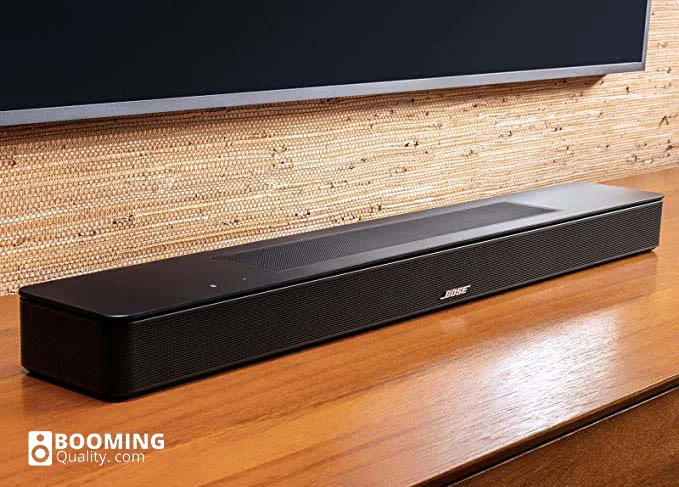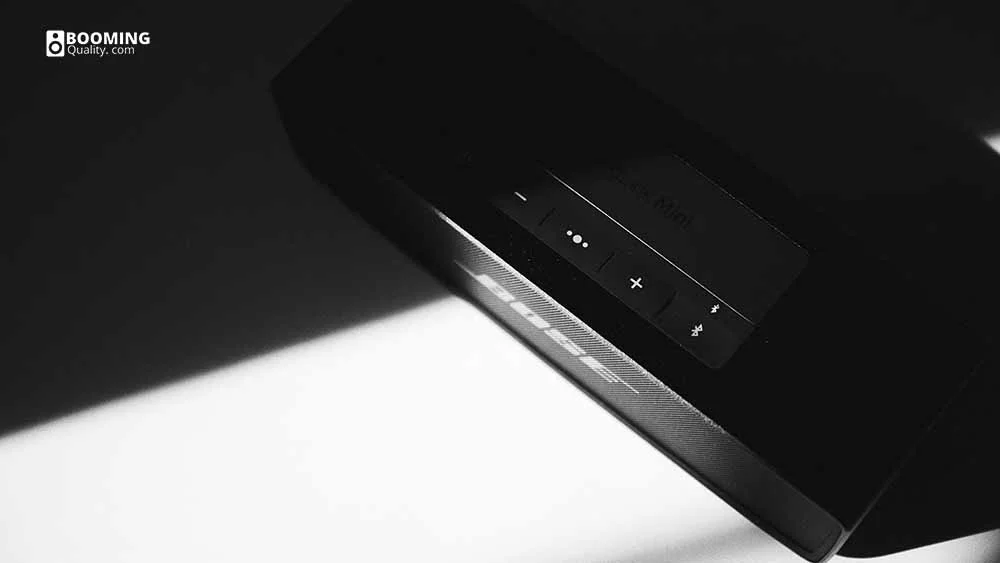
Connecting a Bose soundbar to your TV is a simple way to elevate your listening experience. Bose is a well-known sound company that has been providing excellent-quality sound products for a number of years.
Their soundbars and other audio equipment have been popular for their sound quality and easy setup methods.
In this article, we will provide a step-by-step guide to help you connect your Bose soundbar bar to your TV. While offering troubleshooting methods and some tips for a smooth process.
Whether you’re new to this or an experienced audiophile, we can help you get the most out of your soundbar.
Additionally, click here for a comparison of Sonos Beam versus Bose or find the best soundbar for LG CX TV.

Utilize HDMI ARC for a simplified setup, allowing the soundbar to sync with your TV automatically.
Ensure both the soundbar and TV are updated to the latest firmware for optimal compatibility.
Explore the sound settings on your TV to customize audio output according to your preferences.
Instructions for TV & Bose Soundbar Setup
Connecting TV to Soundbar
- First, find the HDMI ARC input on your TV’s back. If your TV does not have an ARC input then you can use an optical cable.
- Insert one end of the HDMI into the HDMI ARC input on the TV.
- Insert the other end of the HDMI ARC cable into your soundbar ARC input.
Connecting Soundbar to Power
- Plug one end of the power cord into the soundbar
- Plug the other end into a power outlet
On a mobile device, download the SoundTouch app for further instructions on setup.
Using SoundTouch App
- Make sure Bluetooth is turned on and location switched on and allowed on the app.
- Open the app and create an account
- Connect it to your WiFi
- Connect your soundbar to the Bose SoundTouch Network
- Follow the instructions on your screen and if you do not see the network tap “I DO NOT SEE THIS NETWORK” for alternative instructions
- Enter your name for the system and if you need to add other devices you can do so at this point
If you have no other devices to connect to the network click ‘No’ to finish.
Additional Setup Features
Bose soundbars have the ADAPTiQ feature, which means the soundbar can test the acoustics for the room to calibrate itself and deliver the best sound adjusted to your space.
To set this up to receive the best sound follow these steps…
- Download the Bose Music App
- Sign in or create an account
- Turn on Bluetooth on your mobile device and the light bar on the front of your soundbar should be glowing amber
- On your app, select the “Smart Speakers, Soundbars & Amps” option
- You will get some images, if this is your soundbar select “add”. If the model that the app has shown you is not your soundbar, swipe left to see other products until you find the correct one
- The “Set up my product” button will appear, either click that or if it doesn’t head over to the My Bose icon and tap the + sign.
- You then need to select your wireless network and enter the password for it to connect.
- Create a custom name or just choose the name of your soundbar.
- If you have any other Bose products you want to connect such as the subwoofer then you can do so on this next step and if not just press the ‘do it later’ button.
You can now set up the ADAPTiQ feature, to do this follow these next steps.
- The ADAPTiQ screen will appear after following the previous setup instructions on the Bose Music App.
- Press “Get Started” and your Bose soundbar will then calibrate itself to suit your room. This takes a few minutes but will be worth it for an optimized experience.
Voice Control Options
The latest Bose models usually have the added feature of being able to add your Google Assistant or Alexa device to allow it to take commands from your voice.
Click on the links if you want to hook up your Bose soundbar to TV by the following:
Add or remove a Google Assistant device

Troubleshooting Connectivity Issues
While connecting your Bose soundbar to your TV is generally a straightforward process, occasional issues may arise.
Here are some common connectivity problems and possible solutions you can try from home to fix the issue you’re having:
No Sound from the Soundbar
Solution:
- Check the Audio Source: Ensure that your TV’s audio output is set to the correct source. You may need to select “external speaker” or “soundbar” in your TV’s settings.
- Volume Control: Verify that the soundbar’s volume is not muted or set too low. Use the soundbar’s remote control or app to adjust the volume.
- Cable Connection: Recheck the cable connections, whether it’s HDMI, optical, or Bluetooth pairing. Make sure they are securely plugged in.
HDMI ARC Issues
Solution:
- Check HDMI ARC Port: Ensure you’ve connected the HDMI cable to the correct HDMI ARC port on your TV. This port is typically labeled “ARC” or “HDMI Out (ARC).
- Enable HDMI CEC: In your TV settings, enable HDMI CEC or a similar feature (e.g., Anynet+ for Samsung TVs). This allows the TV remote to control the soundbar.
- Power Cycle: Try power cycling both the TV and the soundbar. Turn them off, unplug them from the power source, wait for a few minutes, and then plug them back in and power them on.
Bluetooth Pairing Problems
Solution:
- Ensure Bluetooth Compatibility: Confirm that your TV has Bluetooth capability. Not all TVs support Bluetooth, so if yours doesn’t, you may need an external Bluetooth transmitter.
- Pairing Mode: Make sure your Bose soundbar is in pairing mode. Consult the soundbar’s user manual for instructions on how to initiate pairing.
- Clear Paired Devices: If you’ve paired your soundbar with multiple devices before, clear the paired devices list and try pairing it with your TV again.
Audio Delay (Lip Sync Issues)
Solution:
- Adjust Settings: Access your TV’s audio settings and look for an option related to audio delay or lip sync. You can often adjust this setting to match the audio with the video.
- Soundbar Delay: Some Bose soundbars allow you to adjust audio delay through their settings or app. Experiment with this setting to sync audio with video.
Limited Sound Quality
Solution:
- Audio Format Compatibility: Verify that the audio format from your TV (e.g., Dolby Digital, DTS) is supported by your Bose soundbar. In some cases, you may need to adjust your TV’s audio settings to match the soundbar’s capabilities.
- Firmware Updates: Check if any firmware updates are available for your Bose soundbar. Updating the firmware can resolve compatibility issues and improve sound quality.
If you encounter persistent connectivity problems that you cannot resolve, consider consulting the user manual for your specific TV and Bose soundbar models or reaching out to customer support for further assistance.
Troubleshooting can vary based on the TV brand and soundbar model, so having the relevant documentation on hand helps resolve issues.
Sound Modes and Settings
Once you’ve successfully connected your Bose soundbar to your TV, it’s time to explore the various sound modes and settings to customize your audio experience.
Bose soundbars typically offer a range of sound modes and settings that allow you to tailor the sound to your preferences and the content you’re watching.
Here’s a breakdown of some common sound modes and settings you might find on your Bose soundbar:
1. Dialogue Mode:
Purpose: Enhancing dialogue clarity in movies and TV shows.
How it works: Dialogue mode amplifies spoken words and makes them more distinct, especially during scenes with background noise or action sequences. It’s particularly useful for ensuring that you can hear conversations clearly without adjusting the volume frequently.
When to use: Use Dialogue Mode when you’re watching dialog-heavy content like dramas or news programs, or great for people with hearing loss to provide better clarity.
2. Bass and Treble Controls:
Purpose: Adjust the balance of low-frequency (bass) and high-frequency (treble) sounds.
How it works: These controls allow you to fine-tune the audio by boosting or reducing the bass and treble frequencies. Increasing the bass adds depth to music and action scenes, while adjusting the treble can make dialogues and high-pitched sounds crisper.
When to use: Customize the bass and treble settings based on your preferences and the type of content you’re enjoying. For example, boost the bass for action movies or reduce it for late-night TV watching.
3. Equalizer (EQ) Presets:
Purpose: Predefined sound profiles optimized for different types of content.
How it works: Bose soundbars often come with EQ presets like “Movie,” “Music,” and “Sports.” Each preset adjusts various audio parameters such as bass, treble, and balance to suit the genre of content you’re watching or listening to.
When to use: Select an EQ preset that matches your current activity. For instance, choose the “Music” preset for music playback and “Movie” for cinematic experiences.
4. Night Mode:
Purpose: Maintaining audio clarity at lower volumes during nighttime viewing.
How it works: Night Mode reduces the dynamic range of sound, making soft sounds more audible and loud sounds quieter. This ensures that you can hear dialogues and subtle details without disturbing others in your household when watching late at night.
When to use: Engage Night Mode to enjoy TV shows or movies without disturbing anyone else in your home during quiet hours.
5. Surround Sound and Virtual Surround
Purpose: Creating a more immersive audio experience.
How it works: Some Bose soundbars offer surround sound features that simulate a multi-speaker setup, providing a broader soundstage. Virtual Surround modes replicate the sensation of surround sound without requiring physical rear speakers.
When to use: Activate these modes when watching movies that benefit from immersive sound or when you want to enhance your audio experience.
6. Subwoofer Adjustments:
Purpose: Controlling the output of the subwoofer.
How it works: If you have a compatible Bose subwoofer, you can adjust its volume level and settings to fine-tune the bass output. This ensures that the subwoofer complements the soundbar’s performance.
When to use: Use subwoofer adjustments to achieve the desired level of bass response for your audio setup.
Remember that the availability of these sound modes and settings may vary depending on your specific Bose soundbar model. Consult your soundbar’s user manual or app for detailed instructions on accessing and customizing these features. Exploring these options allows you to personalize your audio experience to match your preferences and the content you’re enjoying.

Soundbar Placement
Proper placement of your Bose soundbar is crucial to achieving the best audio quality and overall home theater experience, whether you have a TV or a projector.
Here are some essential considerations for placing your soundbar effectively and the pros and cons of the different placements:
Below the TV
Pros:
- A common and visually pleasing placement option.
- Allows for a clean and uncluttered look.
- Ideal for soundbars designed to sit on a TV stand or entertainment center.
Cons:
- Limited space for larger soundbars with multiple drivers.
- Can obstruct the TV’s remote sensor if the soundbar is too tall.
Wall-Mounted
Pros:
- Maximizes floor space, creating a minimalist look.
- Reduces the risk of obstructions and clutter.
- It is ideal for sleek soundbars designed for wall mounting.
Cons:
- May require professional installation, including drilling into the wall.
- Placement height should align with ear level when seated for the best sound experience.
Above the TV
Pros:
- Suitable for TVs mounted on the wall or placed on low-profile TV stands.
- Provides more space for larger soundbars with multiple drivers.
- Can improve sound dispersion and clarity.
Cons:
- May not be aesthetically pleasing in all setups.
- Requires proper positioning to prevent blocking the TV screen.
In a Cabinet or Furniture
Pros:
- Conceals the soundbar for a clean and clutter-free appearance.
- Ideal for integrating the soundbar into custom cabinetry or entertainment centers.
Cons:
- May impact sound quality if the cabinet or furniture doesn’t allow for proper sound dispersion.
On a Speaker Stand
Pros:
- Elevates the soundbar for improved sound projection.
- Allows for flexible placement anywhere in the room.
Cons:
- Requires an additional stand or shelf.
- May not be suitable for all soundbar models.
Updating Firmware Guide
Regularly checking for and installing firmware updates ensures that your Bose soundbar stays current and performs at its best, providing you with the latest features and improvements.
This is how you can do this:
- Check for Updates: Visit the official Bose website and navigate to the support or downloads section. Search for your specific soundbar model and check if any firmware updates are available.
- Download and Install: If an update is available, download the firmware file to your computer. Follow the provided instructions to install the update onto your soundbar.
- Use the Bose App: Some Bose soundbars offer the option to update firmware using the Bose Music app. Simply connect your soundbar to the app and check for updates in the settings menu.
- Automatic Updates: In some cases, your Bose soundbar may offer automatic firmware updates when connected to Wi-Fi. Ensure your soundbar is connected to the internet and configured for automatic updates if this feature is available.
Additional Devices
Your Bose soundbar is not limited to just enhancing your TV’s audio – it can also serve as a hub for various other audio sources.
Here’s how to connect additional devices to your soundbar for a more versatile entertainment setup:
Gaming Consoles
- HDMI Connection: Use an HDMI cable to connect the gaming console to one of the HDMI input ports on your TV. Then, use an HDMI ARC or optical cable to connect your TV’s audio output to the soundbar.
- Audio Settings: In your TV’s audio settings, make sure to select the external speaker or soundbar as the audio output source.
- Soundbar Control: Ensure that the soundbar is powered on and set to the correct input source (e.g., HDMI, optical) to match your gaming console.
DVD/Blu-Ray Players
- HDMI Connection: Connect the Blu-ray or DVD player to one of the HDMI input ports on your TV. Then, use an HDMI ARC or optical cable to connect your TV’s audio output to the soundbar.
- Audio Settings: In your TV’s audio settings, select the external speaker or soundbar as the audio output source.
- Soundbar Control: Make sure the soundbar is powered on and set to the correct input source (e.g., HDMI, optical) corresponding to your Blu-ray/DVD player.
Streaming Devices
- HDMI Connection: Connect the streaming device to one of the HDMI input ports on your TV. Then, use an HDMI ARC or optical cable to connect your TV’s audio output to the soundbar.
- Audio Settings: In your TV’s audio settings, designate the external speaker or soundbar as the audio output source.
- Soundbar Control: Ensure the soundbar is powered on and set to the appropriate input source (e.g., HDMI, optical) that corresponds to your streaming device.
FAQs
Why won’t my Bose soundbar connect to my TV?
This could be for a number of reasons. You may need to troubleshoot a few things to find out what the issue is. Try the following things to see if these work:
Make sure all of your wires are secure and properly plugged in.
If they are, try turning off your TV and soundbar, unplugging them for a few minutes, plugging them back in, and powering them on.
Still not connected? Check your TV’s on-screen settings, and make sure your output is set to “external speakers” or “audio system”.
If everything seems in order check your TV is compatible with the Bose soundbar. If you have previously had it connected check for any TV or Bose updates that you can install, if you need to update the firmware this is what could be preventing it from connecting.
If you have followed these steps and still have no luck, please contact Bose customer support here to assist you further.
How do I connect my Bose soundbar to my TV wirelessly?
Before buying a Bose soundbar please check the model compatibility with your TV. You can connect your Bose soundbar using Bluetooth, Wi-Fi, or a wired internet cable such as an Ethernet cable.
For more instructions follow the instructions above.
How do I connect my Bose soundbar to my TV without HDMI ARC?
If you do not have an HDMI ARC port on your TV, you can use an optical cable.
- Plug one end of the optical cable into your TV’s port usually labeled “optical audio out” or “digital audio out (optical)”.
- Plug the other end into the optical input port on the soundbar.
- Make sure both devices are set to use the optical input through the settings.
Please note, that using an optical cable as a replacement for HDMI ARC may limit some of the advanced features you can use such as Dolby Atmos or DTS:X.
For information on other brands of soundbars check out our Samsung Soundbar review and Samsung Soundbar Support.

Written By Emily
We post new content every month, if you enjoyed this, follow us for more content like this one.
